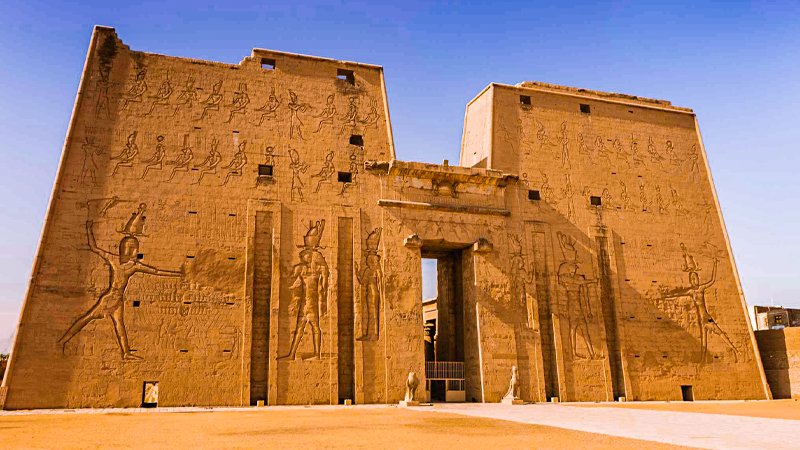Nestled on the west bank of the Nile River, the Temple of Edfu stands as a testament to the enduring power of ancient Egyptian beliefs and architectural mastery. Dedicated to Horus, the falcon-headed god of the sky and kingship, this remarkably well-preserved temple complex offers a captivating glimpse into the religious and cultural practices of the Ptolemaic era. Join us as we embark on a virtual tour of Edfu Temple, exploring its history, architectural splendor, and the fascinating myths and rituals that once unfolded within its sacred walls.
A Temple Reborn: The Construction of Edfu
The Temple of Edfu, one of the best-preserved ancient Egyptian temples, was built over 180 years during the Ptolemaic Kingdom (332-30 BC). Its construction began in 237 BC under Ptolemy III Euergetes and was completed in 57 BC under Ptolemy XII Auletes. The temple was built on the site of an earlier temple dedicated to Horus, which had fallen into ruin. The new temple was designed to be a grander and more impressive structure, reflecting the wealth and power of the Ptolemaic dynasty.
Architectural Splendor: A Masterpiece of Ptolemaic Design
The Temple of Edfu is a masterpiece of Ptolemaic architecture, boasting a harmonious blend of Egyptian and Greek elements. Its imposing pylon, adorned with reliefs depicting Ptolemy XII smiting his enemies, leads to a spacious courtyard surrounded by colonnades. The hypostyle hall, a forest of towering columns adorned with intricate carvings, creates a sense of awe and reverence. The inner sanctum, the most sacred part of the temple, once housed the golden statue of Horus, the temple’s principal deity.
The Myth of Horus and Seth: A Tale of Vengeance and Triumph
The Temple of Edfu is not just an architectural marvel; it is also a repository of ancient myths and legends. The temple’s reliefs and inscriptions depict the story of Horus, the son of Osiris and Isis, and his epic battle against his uncle Seth, the god of chaos and destruction. This mythological struggle represents the eternal conflict between good and evil, order and chaos, and light and darkness. The Temple of Edfu served as a stage for the reenactment of this myth through annual festivals and rituals, reinforcing the importance of Horus as a protector of the pharaoh and the Egyptian people.
Rituals and Ceremonies: Honoring the Falcon God
The Temple of Edfu was a center of religious activity, where priests performed daily rituals and ceremonies to honor Horus and ensure the well-being of the pharaoh and the nation. These rituals involved offerings of food, incense, and libations, as well as the recitation of prayers and hymns. The temple’s sacred barque, a ceremonial boat that housed the statue of Horus, was paraded through the temple complex during festivals, symbolizing the god’s journey through the heavens.
A Window into Ptolemaic Life: Reliefs and Inscriptions
The Temple of Edfu’s walls are covered with intricate reliefs and inscriptions that provide valuable insights into the religious, cultural, and political life of the Ptolemaic era. The reliefs depict scenes of pharaohs making offerings to the gods, priests performing rituals, and mythological figures engaged in various activities. The inscriptions, written in hieroglyphics, demotic, and Greek, offer a wealth of information about the temple’s construction, its religious significance, and the daily lives of its priests and worshippers.
The Nilometer: Measuring the Life-Giving River
One of the most intriguing features of Edfu Temple is its nilometer, a well-like structure used to measure the Nile River’s water level. The nilometer was crucial for predicting the annual floods, which were essential for agriculture and the sustenance of life in ancient Egypt. The Temple of Edfu’s nilometer is one of the best-preserved examples of this ancient technology.
Practical Tips for Visiting Edfu Temple
Location: Edfu Temple is located on the west bank of the Nile River, about 100 kilometers (62 miles) south of Luxor.
Getting there: Most visitors reach Edfu Temple by taking a Nile cruise or a day trip from Luxor or Aswan.
Best time to visit: The best time to visit is during the cooler months, from October to April, to avoid the scorching summer heat.
What to wear: Dress modestly, especially when visiting the temple. Bring a hat, sunglasses, and sunscreen to protect yourself from the sun.
Photography: Photography is allowed inside the temple complex, but flash photography is prohibited.
Edfu Temple – A Glimpse into Egypt’s Glorious Past
The Temple of Edfu, a magnificent monument to the falcon god Horus, offers a captivating journey into ancient Egypt’s rich history and cultural heritage. Its well-preserved architecture, intricate reliefs, and fascinating myths and legends transport visitors to a time when gods and goddesses reigned supreme. A visit to Edfu Temple is an unforgettable experience, providing a unique opportunity to connect with the past and marvel at the enduring legacy of the ancient Egyptians.

